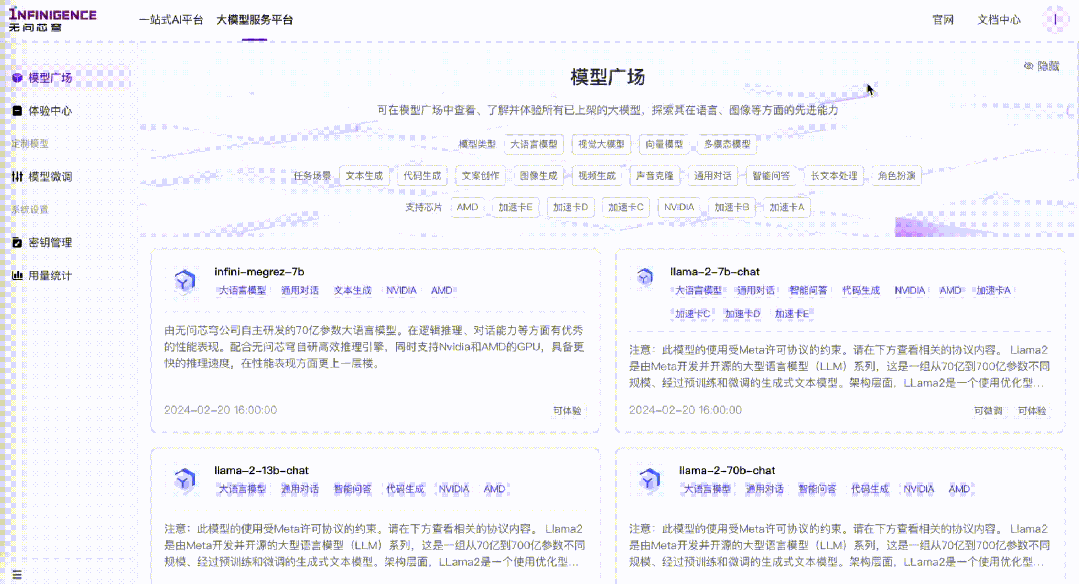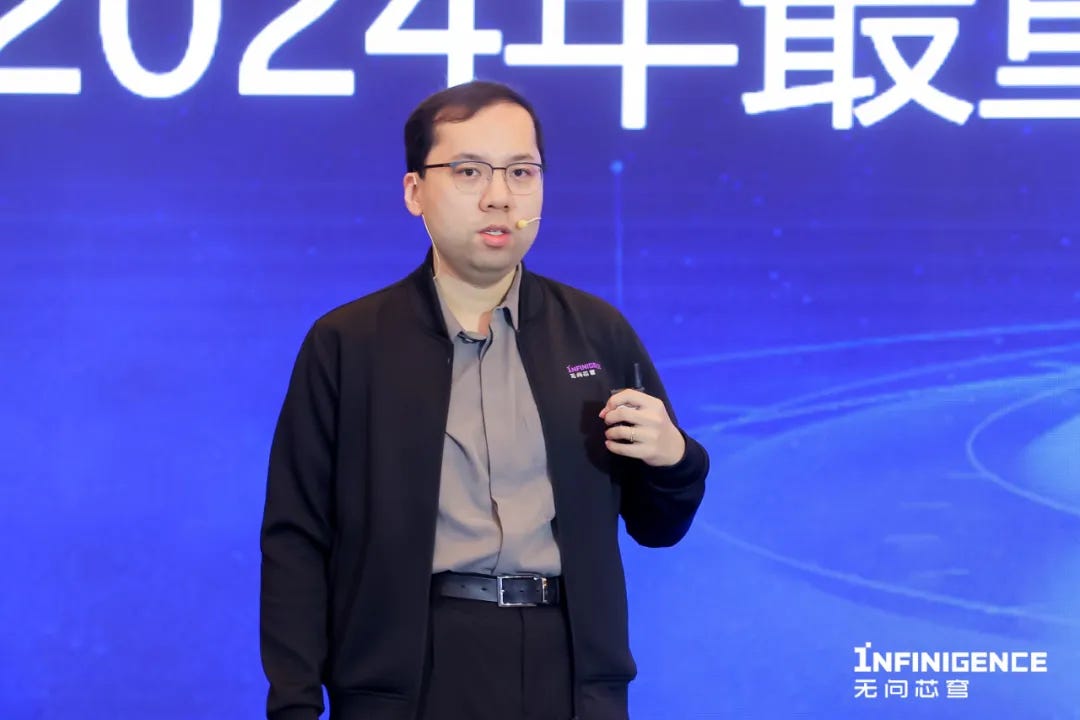Wuwen Xinqiong: The Company Creating a 'Taobao' in LLM Computing Power
Data shows that as of 2023, China's total computing power ranks second globally, with an average annual growth rate of nearly 30% in the past five years. Nevertheless, the AI industry's first impression is that computing power is insufficient.
Recently, a Tsinghua-based start-up company set its sights in this direction.
The company, named "Wuwen Xinqiong" (无问芯穹), was initiated by Wang Yu(汪玉), the head of the Department of Electronic Engineering at Tsinghua University, and founded by his student Xia Lixue(夏立雪). Therefore, the company's name carries a strong Tsinghua imprint—the Tsinghua University school song written in 1924 by Tsinghua University Professor of Sinology Wang Luanxiang contains the line, "Establish virtue and speak uprightly, without concern for the West or the East."(立德立言,无问西东)
Since its establishment in May last year, "Wuwen Xinqiong" has received support from internet companies, AI companies, and well-known investment institutions within five months. Their shareholder list includes Baidu, Tencent, Zhipu AI, Sequoia China, GSR Ventures, and more.
Recently, Xia Lixue, the founder and CEO of Wuwen Xinqiong, exchanged with Emerging Intelligence, an affiliated tech self-media of 36Kr Group. According to Xia, one obstacle to deploying LLMs is the huge mismatch between demand and supply in computing power.
On the one hand, there is a huge global shortage of GPUs, and Nvidia alone cannot meet all the global AI LLM training and inference needs. On the other hand, diverse heterogeneous GPUs outside of Nvidia are also rapidly developing, and the AI computing power ecosystem is dispersed, making it difficult to integrate and supply to LLM companies in dire need of computing power.
Xia Lixue observed that the current anxiety over computing power manifests in several common ways:
Some companies cannot find the computing power that meets their business needs; others find computing power but don't know how to utilize these bare-metal resources; and there are those fortunate enough to find and know how to use computing power, but struggle with incompatible or inefficient toolchains, leading to unreasonably delayed product deployment.
The AI industry, constrained by insufficient computing power, is already showing signs of division.
Currently, some AI companies are "hesitating to continue," while others are more straightforward—"there's no need to rush into GPT-5, better to explore where GPT-4 can be applied."
However, Xia Lixue does not want the industry to remain passive due to computing power limitations. To bridge the gap between demand and supply and make computing power more accessible, "Wuwen Xinqiong" was founded. This company is a rare foray into the computing power direction among Tsinghua-affiliated AI startups.
But "Wuwen Xinqiong" does not aim to be another Nvidia; instead, it approaches the issue from a more agile perspective.
According to Xia, "Wuwen Xinqiong" acts as a flexible middle layer between LLMs and chips, enabling the uniform deployment of the diverse world of LLMs and heterogeneous hardware.
In other words, "Wuwen Xinqiong" serves as a "Taobao"(淘宝) in the field of LLM computing power, where downstream LLM manufacturers and application parties can easily acquire effective and efficient computing power. This computing power comes from a variety of chips.
Currently, "Wuwen Xinqiong's" "Infini-AI" platform supports over 20 models, including Llama2 and Baichuan2, as well as more than ten types of computing cards from AMD, Wallston, Cambricon, Suiyuan, Tianshu Zhixin, Muxi, Moore Threads, Nvidia, and others.
Wuwen Xinqiong's large model service platform
Achieving inclusive computing power has shown significant effects. Xia Lixue mentioned that their partner, "Tongdao Liepin,"(同道猎聘), launched new AI-driven features, such as digital human interviewers in some cities, utilizing the computing power solutions provided by "Wuwen Xinqiong." "The ROI (Return on Investment) of the first deployment phase was much higher than the original solution."
The related collaboration is progressing rapidly. On March 31st, "Wuwen Xinqiong" announced a series of industrial cooperation updates—including launching an LLM training and deployment plan with Zhipu AI to build a cluster of ten thousand computing cards for LLM training and inference and exploring the deployment and performance enhancement of LLMs on edge-side hardware in cooperation with UNISOC(紫光展锐).
"We position ourselves in the middleware layer, where coordination becomes crucial. We hope to connect the industry's upstream and downstream resources, unite everyone, and bring AGI to thousands of households nationwide," Xia Lixue believes.
However, creating a middleware product, especially in the complex field of computing power, demands a lot from the team. To meet these demands, "Wuwen Xinqiong" has assembled a team with extensive experience in managing large-scale computing clusters.
Regarding the team, Xia Lixue formerly served as the technical lead for user growth products at Alibaba Cloud, where he was responsible for strategic projects such as the compression acceleration of Alibaba Cloud's LLMs and generative AI model chips.
Xia Lixue
Co-founder and CTO Yan Shengen(颜深根) used to be the executive director of the data and computing platform department of SenseTime Technology, and helped SenseTime build a large-scale AI computing platform with 20,000 GPUs; another co-founder and chief scientist, Dai Guohao(戴国浩), is currently a long-term associate professor at Shanghai Jiao Tong University and the head of the artificial intelligence design automation innovation laboratory at Qingyuan Research Institute(清源研究院人工智能设计自动化创新实验室).
Xia Lixue said, 'Only those who have worked on the Wanka cluster can know what pitfalls there are and how to make a good platform product.'
The following is the exchange between "Intelligent Emergence" and Xia Lixue:
The game of the computing power industry
Emerging Intelligence:
How have large model companies addressed the shortage of computing power over the past year? Do they still experience anxiety about computing power?
Xia Lixue:
Currently, large model companies are still quite financially robust; their main anxiety lies in not finding the scale of computing power they need. Moreover, many cloud service providers are also developing LLMs, further reducing the availability of computing power on the cloud. This has forced many large model companies to directly purchase machines.
The restrictions imposed by the United States caught everyone off guard, and as model sizes continue to grow, the anxiety over computing power is expected to persist. To develop a model of GPT-4 level or above, a cluster of at least ten thousand cards is required. What can those who don't have access to so many cards do?
Most major manufacturers and large model startups essentially want to build their own supercomputing power, but not all big companies have a single cluster that can reach more than 5,000 cards domestically. On the other hand, the demand for inference machines is also gradually increasing.
Emerging Intelligence:
With the high cost of computing power, is it leading to some divergent trends now?
Xia Lixue:
Yes. When Nvidia's H series chips were priced at 50,000 RMB to 60,000 RMB, everyone was willing to rent them. When the price rose to 80,000 RMB or even 90,000 RMB, many had to consider whether they wanted to invest so much.
Although the prices have not continued to rise, they are still at the boundary line of testing who is willing to proceed. Many companies might think there's no need to rush into GPT-5; instead, they explore where GPT-4 or even 3.5 can be deployed in specific scenarios, leading to a gradual divergence in paths.
Emerging Intelligence:
Can you help us systematically understand the current value chain of AI computing power?
Xia Lixue:
If we're talking about the complete supply chain, the most upstream are those who create computing power. However, this industry originally did not have such high profits, but Nvidia has become dominant, essentially forming a monopoly. AMD is also a player at this layer.
Moving downstream, there are IDCs, which are companies that assemble Nvidia chips and other hardware into clusters, providing the digital era's equivalent of water, electricity, and coal in terms of value. Further down are the large model companies and even more downstream industry companies.
However, there's another way to organize this because LLMs themselves are a technological breakthrough that brought about an industry. So, large model companies are considered the foundation of this industry. They produce new technologies that impact downstream applications and generate new computing power demands that affect the upstream supply. It's evident that the iteration of this industry is driven by large model companies. After all, when talking about the era of LLMs, people would attribute it to OpenAI, not Nvidia.
In summary, computing power is the most critical supply source, and models are the most advanced technology source. The efficiency of connecting these two is very important.
Keep reading with a 7-day free trial
Subscribe to Geopolitechs to keep reading this post and get 7 days of free access to the full post archives.



